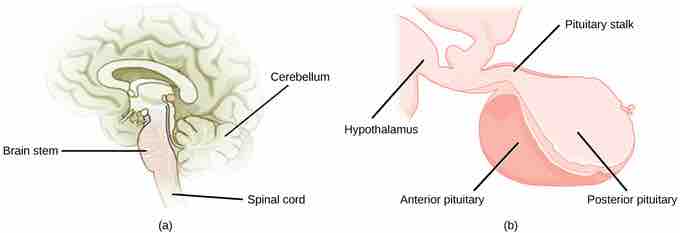The Endocrine System
The endocrine system uses chemical signals to communicate and regulate the body's physiology. The system releases hormones that act on target cells to regulate development, growth, energy metabolism, reproduction, and many behaviors. Endocrine glands contain no ducts; they release their secretions directly into the intercellular fluid or into the blood. The collection of these glands makes up the endocrine system. The main endocrine glands, which we will learn about in this section and in the following ones, are the pituitary (anterior and posterior), thyroid, parathyroid, adrenal (cortex and medulla), pancreas, and gonads.
Hypothalamic-Pituitary Axis
The hypothalamus in vertebrates integrates the endocrine and nervous systems. The hypothalamus is an endocrine organ located in the diencephalon of the brain. It receives input from the body and other brain areas, initiating endocrine responses to environmental changes. The hypothalamus acts as an endocrine organ as it synthesizes hormones and transports them along axons to the posterior pituitary gland. The hypothalamus also synthesizes and secretes regulatory hormones that control the endocrine cells in the anterior pituitary gland. In addition, it contains autonomic centers that control endocrine cells in the adrenal medulla via neuronal control.
The pituitary gland, sometimes called the hypophysis or "master gland," is located at the base of the brain in the sella turcica, a groove of the sphenoid bone of the skull. It is attached to the hypothalamus via a stalk called the pituitary stalk (or infundibulum) . The pituitary has two distinct regions: the anterior pituitary and the posterior pituitary. These regions secrete nine different peptide or protein hormones. The anterior portion of the pituitary gland is regulated by releasing or release-inhibiting hormones produced by the hypothalamus. The posterior pituitary receives signals via neurosecretory cells to release hormones produced by the hypothalamus.

Pituitary gland
The pituitary gland is located at (a) the base of the brain and is (b) connected to the hypothalamus by the pituitary stalk.
Anterior Pituitary Gland
The anterior pituitary gland, or adenohypophysis, is surrounded by a capillary network that extends from the hypothalamus, down along the infundibulum, and to the anterior pituitary. This capillary network is a part of the hypophyseal portal system which carries substances from the hypothalamus to the anterior pituitary and hormones from the anterior pituitary into the circulatory system. A portal system carries blood from one capillary network to another; therefore, the hypophyseal portal system allows hormones produced by the hypothalamus to be carried directly to the anterior pituitary without first entering the circulatory system.
The anterior pituitary produces seven hormones: growth hormone (GH), prolactin (PRL), thyroid-stimulating hormone (TSH), melanin-stimulating hormone (MSH), adrenocorticotropic hormone (ACTH), follicle-stimulating hormone (FSH), and luteinizing hormone (LH). Anterior pituitary hormones are sometimes referred to as tropic hormones because they control the functioning of other organs. While these hormones are produced by the anterior pituitary, their production is controlled by regulatory hormones produced by the hypothalamus. These regulatory hormones can be releasing hormones or inhibiting hormones, causing more or less of the anterior pituitary hormones to be secreted. The regulatory hormones travel from the hypothalamus through the hypophyseal portal system to the anterior pituitary where they exert their effect. Negative feedback then regulates how much of these regulatory hormones are released and how much anterior pituitary hormone is secreted.
Posterior Pituitary Gland
The posterior pituitary is significantly different in structure from the anterior pituitary. It is a part of the brain, extending down from the hypothalamus, and contains mostly nerve fibers and neuroglial cells which support axons that extend from the hypothalamus to the posterior pituitary. The posterior pituitary and the infundibulum together are referred to as the neurohypophysis.
The antidiuretic hormone (ADH) (or vasopressin) and oxytocin are produced by neurons in the hypothalamus and transported within these axons along the infundibulum to the posterior pituitary. They are released into the circulatory system via neural signaling from the hypothalamus. These hormones are considered to be posterior pituitary hormones even though they are produced by the hypothalamus, since that is where they are released into the circulatory system. The posterior pituitary itself does not produce hormones, but instead stores hormones produced by the hypothalamus, releasing them into the blood stream. Vasopressin has two primary functions: to retain water in the body and to constrict blood vessels. The hormone regulates the body's retention of water by acting to increase water absorption in the collecting ducts of the kidney nephron. Oxytocin, known as the bonding hormone, has roles in various behaviors, including orgasm, social recognition, pair bonding, anxiety, and maternal behaviors. The hormone has been found to be released in large amounts after distension of the cervix and uterus during labor, facilitating birth, maternal bonding, and lactation.